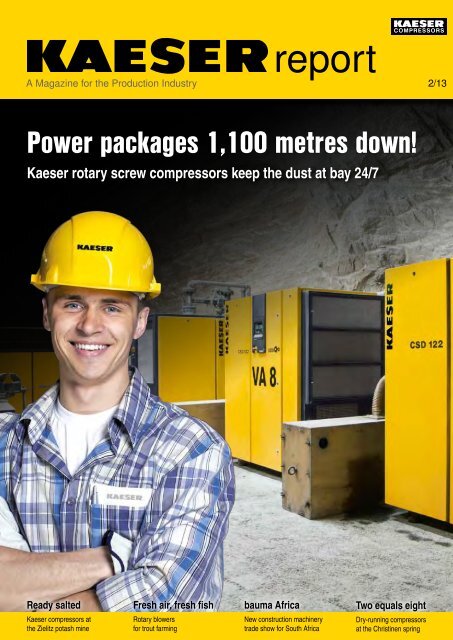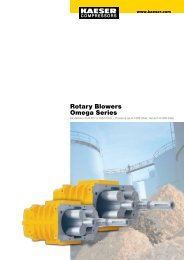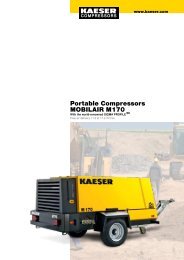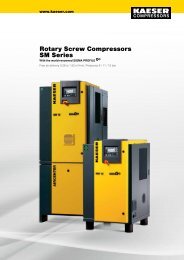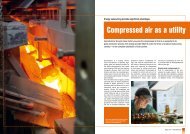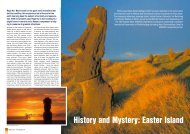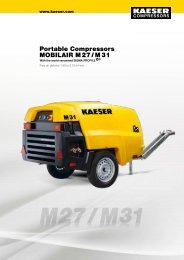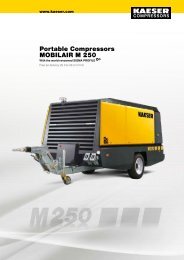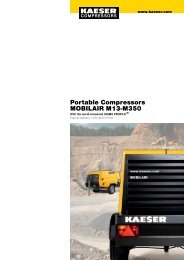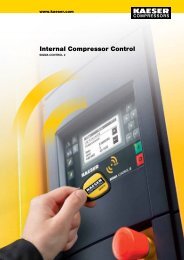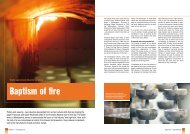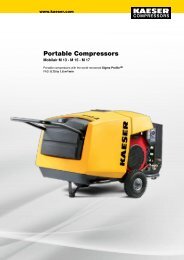report - Kaeser Kompressoren
report - Kaeser Kompressoren
report - Kaeser Kompressoren
You also want an ePaper? Increase the reach of your titles
YUMPU automatically turns print PDFs into web optimized ePapers that Google loves.
eport<br />
A Magazine for the Production Industry 2/13<br />
Power packages 1,100 metres down!<br />
<strong>Kaeser</strong> rotary screw compressors keep the dust at bay 24/7<br />
Ready salted<br />
Fresh air, fresh fish<br />
bauma Africa<br />
Two equals eight<br />
<strong>Kaeser</strong> compressors at<br />
the Zielitz potash mine<br />
Rotary blowers<br />
for trout farming<br />
New construction machinery<br />
trade show for South Africa<br />
Dry-running compressors<br />
at the Christinen spring
eport<br />
Contents Issue 2/13<br />
Editorial<br />
3 Editorial<br />
4 Endurance-running in salt dust<br />
<strong>Kaeser</strong> rotary screw compressors – 1,100 metres down<br />
8 bauma Africa<br />
New construction machinery trade show for South Africa<br />
4-7<br />
10 Fresh air, fresh fish<br />
Six rotary blowers for a trout farm<br />
13 Innovative energy savers<br />
ASD and BSD series rotary screw compressors<br />
14 Two equals eight<br />
Dry compression for mineral water production<br />
17 Powder metallurgy in ‘Bergischen Land’<br />
Pay-as-you-go compressed air for GKN Sinter Metals<br />
14-16<br />
20 Bend it!<br />
Compressed air for processing plastics<br />
23 News<br />
<strong>Kaeser</strong> shrinks the refrigeration dryer: The new TF series<br />
17-19<br />
Imprint:<br />
Publisher: KAESER KOMPRESSOREN AG, 96450 Coburg, Germany, Carl-<strong>Kaeser</strong>-Str. 26,<br />
Phone: 49+ 9561 640-0, Fax: 49+ 9561 640-130, www.kaeser.com<br />
Editor: Klaus Dieter Bätz<br />
Photographer: Marcel Hunger<br />
Print: Schneider Printmedien GmbH, Weidhausen<br />
No liability is assumed for unsolicited copy or photos submitted to the editor. Reproduction, even in part,<br />
is only allowed with the written permission of KAESER KOMPRESSOREN AG – P.O. Box 2143 - 96410<br />
Coburg, Germany<br />
Phone: 49+ 9561 640-0, Fax: 49+ 9561 640-130, www.kaeser.com – E-mail: produktinfo@kaeser.com<br />
2<br />
Report 2/13 – www.kaeser.com
eport<br />
Dipl.-Wirtsch.-Ing.<br />
Thomas <strong>Kaeser</strong><br />
Chairman,<br />
Managing Board<br />
Dipl.-Wirtsch.-Ing.<br />
Tina-Maria Vlantoussi-<strong>Kaeser</strong><br />
Managing Board<br />
Industry 4.0: networking adds value<br />
Even though many have yet to realise it, our economy<br />
is in the midst of the fourth industrial revolution:<br />
Industry 4.0.<br />
The Internet is merging our physical and virtual worlds<br />
– goods and services (machines, people, information<br />
and resources) are being totally networked.<br />
Cyber-physical systems (CPS) are autonomous<br />
systems consisting of data, as well as electronic and<br />
mechanical components. These systems are able to<br />
communicate via networks such as the Internet.<br />
In other words, they are smart distributed data stores<br />
and data generators that are easily networked via any<br />
conceivable communications medium. The extremely<br />
large number of Internet addresses required to identify<br />
the cyber-physical systems are available thanks to the<br />
increasing prevalence of the new IPv6 Internet protocol.<br />
For example, compressor operating status and data<br />
can now be <strong>report</strong>ed automatically (M2M – machine-tomachine).<br />
This data can then be immediately compared<br />
to statistical models in real time to predict potential problems<br />
and avoid them by taking the appropriate action.<br />
Predictive maintenance can minimise costly unplanned<br />
outages and cut repair and maintenance costs through<br />
improved planning.<br />
Energy consumption can also be monitored and<br />
analysed continuously, so that users can optimise a<br />
system’s energy efficiency at all times.<br />
These new processes have a direct, real impact on<br />
customers’ operations as they maximise system<br />
uptime, minimise maintenance and repair costs and<br />
continuously improve energy efficiency.<br />
Industry 4.0, based on cyber-physical systems, is not a<br />
theoretical vision of the distant future, but is here now<br />
and can be applied to provide direct real benefits that<br />
help our customers.<br />
Thomas <strong>Kaeser</strong><br />
Tina-Maria Vlantoussi-<strong>Kaeser</strong><br />
Report 2/13 – www.kaeser.com 3
<strong>Kaeser</strong> rotary screw compressors – 1,100 metres down<br />
Endurance-running<br />
Zielitz near Magdeburg: Deep<br />
underground, in the huge<br />
potash mine that<br />
has been owned by<br />
in salt dust<br />
Kassel-based<br />
K+S Kali<br />
GmbH since<br />
the end of<br />
1993, compressed<br />
air plays a huge role<br />
in reliable operation – in the<br />
most inhospitable conditions.<br />
As we cross the covered bridge known<br />
as the pit bank, which spans the distance<br />
between the pit baths and the entrance<br />
to the cage, we enter the world of<br />
miners: face workers, pit foremen and<br />
mine surveyors. The cage, which is one<br />
of the largest of its type, can also carry<br />
all of the materials and machinery used<br />
below grade. Suspended from two steel<br />
cables forty-eight millimetres in diameter,<br />
it travels eight metres per second<br />
to a depth of 800 metres. On the left,<br />
not far from our underground stop, Saint<br />
Barbara, the miners’ patron saint, greets<br />
us from her niche in the rock. This is the<br />
entrance to the huge underground workings,<br />
which extend almost twenty-five<br />
kilometres from east to west and about<br />
ten kilometres from north to south. We<br />
reach the actual starting point of our<br />
underground journey after passing<br />
through three air doors. The doors allow<br />
fresh air pumped through the air shaft to<br />
reach the miners. In Zielitz, 48,000 cubic<br />
metres per minute, or 83,000 tonnes<br />
per day of fresh air are pumped into the<br />
mine. The miners breathe this air, the<br />
diesel engines installed in vehicles and<br />
portable machinery use it as combustion<br />
air and it serves as intake air for the<br />
more than 100 compressors operating<br />
underground.<br />
Our small group climbs aboard two<br />
all-wheel-drive transport vehicles and<br />
we are on our way to the first stop on<br />
our tour, a nearby compressed air station.<br />
<strong>Kaeser</strong> rotary screw compressors<br />
have been on duty without interruption<br />
Precision computer-controlled drilling machine. The bore holes penetrate seven metres into rock and are subsequently packed<br />
with explosives.<br />
in the Zielitz pit since 1995. Three underground<br />
compressor stations supply<br />
compressed air over a distance of<br />
some thirty kilometres. They deliver air<br />
to the motorised vehicle and machinery<br />
workshops, as well as numerous shock<br />
blowers that are used to clean the conveyor<br />
belt dust collector filters. The<br />
conveyors wind their way almost eighty<br />
kilometres through the mine. In addition<br />
to the compressor stations, there are<br />
numerous stand-alone compressors<br />
distributed throughout the entire underground<br />
workings. They supply air to the<br />
shock blowers connected to the compressed<br />
air lines, but are mainly used to<br />
clean the machines.<br />
Moreover, the air at a depth of 800 to<br />
1,100 metres is parched dry, and the<br />
mining activities kick up a lot of salt<br />
dust. It all starts with drilling three large<br />
holes, each 280 millimetres in diameter,<br />
which penetrate up to seven metres into<br />
the rock and guide blast forces in the<br />
right direction. Additional holes, also<br />
seven metres deep, are drilled according<br />
to an elaborate pattern. These are<br />
the blast holes – thirty-eight millimetres<br />
in diameter and positioned to ensure<br />
that the blasting is properly controlled.<br />
The individual charges are positioned<br />
using compressed air from a pressure<br />
vessel on board the blasting explosives<br />
loading vehicle. The pressure vessel is<br />
filled using air from the compressed air<br />
system.<br />
The blasts are triggered remotely between<br />
shifts, when it is certain that no<br />
workers are left in the vicinity of the<br />
blast zone.<br />
The next shift then starts up the large<br />
mechanical loaders, which pick up the<br />
blasted material using their seventeen<br />
to nineteen-tonne shovels and carry it<br />
to the crushers. From here, over 40,000<br />
tonnes of raw salt is transported on conveyor<br />
belts to the hoisting shaft every<br />
day. Afterwards the miners use huge<br />
scaling jumbos on the back, as the ceiling<br />
of the mine shaft is called. They<br />
scratch away any loose material to pre-<br />
4 Report 2/13 – www.kaeser.com<br />
Report 2/13 – www.kaeser.com 5
One hundred stand-alone compressors distributed throughout the mine are used primarily to blow the dust from the equipment.<br />
vent it from falling spontaneously. In unstable<br />
areas they install expansion bolts<br />
using roof-bolt drilling machines. Small<br />
loaders then remove the loose material<br />
lying on the ground and the cycle starts<br />
over with the drilling of the large holes.<br />
All of this activity fills the air with a considerable<br />
amount of dust: The equipment<br />
and vehicles must be cleaned<br />
regularly using compressed air if they<br />
are to continue operating properly.<br />
Holger Alicke, foreman for systems that<br />
require monitoring, strategically positions<br />
stand-alone ASD 37<br />
<strong>Kaeser</strong> rotary screw compressors<br />
along the<br />
shafts so<br />
that these<br />
machines<br />
do not have<br />
to waste time<br />
and money driving<br />
a long way to<br />
a cleaning station.<br />
Not only did the mine develop cloth bag<br />
filters to clean the intake air for these<br />
compressors, but they also developed<br />
special pallets to minimise interference<br />
and make them easy to carry on trucks<br />
throughout the mine workings. The<br />
compressors were modified by <strong>Kaeser</strong><br />
development engineers in cooperation<br />
with the mining specialists so that they<br />
can operate at high temperatures in<br />
this extremely harsh environment. The<br />
customised compressors are therefore,<br />
to some extent, a unique series of machines.<br />
And just before leaving, we have a<br />
quick peek at the underground central<br />
workshop, which has its own compressor<br />
station with three rotary screw compressors.<br />
As we enter, the Zielitz mine‘s<br />
100th <strong>Kaeser</strong> rotary screw compressor<br />
Compressed air<br />
grade-level factories on the same site,<br />
before being picked and shipped from<br />
the mine. A dedicated compressed air<br />
station equipped with three <strong>Kaeser</strong> rotary<br />
screw compressors and two heat<br />
regenerating desiccant dryers deliver<br />
the service air and control air for these<br />
systems. The dryers ensure that the<br />
compressed air is treated to a pressure<br />
dew point of -25° C, which is essential<br />
when handling such very hygroscopic<br />
raw materials. Two <strong>Kaeser</strong> rotary blowers<br />
are also on site to generate the required<br />
conveying air.<br />
above grade too<br />
is being prepared for its<br />
strenuous mining duty, and<br />
we wish it all the best.<br />
Compressed air above ground<br />
The potash extracted from the mine,<br />
which has been continuously operating<br />
since 1973, is converted to fertilizer<br />
and industrial products – for applications<br />
such as such as chlorine-alkaline<br />
electrolysis in the chemical industry – at<br />
Author: Klaus Dieter Bätz<br />
Contact: klaus-dieter.baetz@kaeser.com<br />
The large machinery is serviced and<br />
maintained underground in specially<br />
equipped and appropriately sized<br />
workshops.<br />
6<br />
Report 2/13 – www.kaeser.com
auma<br />
Messe München International<br />
continues to expand<br />
its international network for<br />
the construction machinery<br />
sector with the launch of a<br />
new event in South Africa. It didn’t<br />
take long before Messe München<br />
had to significantly revise upward<br />
its original estimates of approximately<br />
200 exhibitors and 20,000<br />
square metres of exhibition space<br />
for the first edition of the country’s International<br />
Trade Fair for Construction<br />
Machinery, Building Material Machines,<br />
Mining Machines and Construction<br />
Vehicles. At our editorial deadline 500<br />
exhibitors from 34 countries had already<br />
signed up, requiring an exhibition<br />
area of 60,000 m²! The fair will be<br />
staged at the Gallagher Convention<br />
Centre (GCC) and organisers are expecting<br />
the majority of visitors to come<br />
from the sub-Sahara region. “South<br />
Africa is a market of the future, with<br />
significant potential for the construction<br />
machinery industry.<br />
Messe München<br />
has demonstrated<br />
significant<br />
expertise<br />
in the<br />
construction machinery sector<br />
when staging the fairs for this industry,<br />
not only at its headquarters in<br />
Munich, but also abroad. In addition to<br />
bauma China and a cooperative trade<br />
fair event called bC India, bauma Africa<br />
will offer further professional international<br />
exhibition platforms. Another reason<br />
feedback from the industry for such<br />
sector-specific events is so positive,”<br />
says Eugen Egetenmeir, Managing Director<br />
of Messe München GmbH, and<br />
<strong>Kaeser</strong> agrees.<br />
Africa<br />
<strong>Kaeser</strong> Compressors South Africa will showcase a representative overview<br />
of its comprehensive range of portable compressors at the open-air exhibition<br />
grounds, Stand C.11, at this exciting new fair. Compressed air specialists<br />
from the company’s South African subsidiary look forward to welcoming<br />
visitors and sharing<br />
expert advice and<br />
knowledge.<br />
New construction machinery<br />
trade show for South Africa<br />
Visit us at: Open-air exhibition grounds – Stand C.11<br />
September the 18th – 21st, 2013 in Johannesburg, South Africa<br />
Welcome to <strong>Kaeser</strong> South Africa during bauma Africa<br />
<strong>Kaeser</strong> <strong>Kompressoren</strong><br />
AG’s South African<br />
subsidiary, <strong>Kaeser</strong><br />
Compressors South<br />
Africa, was founded in<br />
2005 in the southeast<br />
sector of Johannesburg.<br />
Geoff Houlgate,<br />
the first manager of<br />
the subsidiary, is still<br />
in charge of the business.<br />
<strong>Kaeser</strong> employees<br />
have established<br />
a strong market share<br />
with steady annual<br />
growth for the company’s entire family<br />
of products in southern Africa’s industrial<br />
and construction sectors. The<br />
success is based on a number of factors,<br />
especially the employees’ professional<br />
experience in the compressed<br />
air field. <strong>Kaeser</strong> South Africa also receives<br />
wholehearted support from its<br />
parent company, <strong>Kaeser</strong> <strong>Kompressoren</strong><br />
AG, a family-owned company based<br />
in Coburg, Germany, which currently<br />
employs approximately 4,500 people<br />
worldwide. Last but not least, thanks<br />
to their reliability and energy efficiency,<br />
<strong>Kaeser</strong> products enjoy an outstanding<br />
reputation. These factors are also the<br />
basis of <strong>Kaeser</strong>’s global success. They<br />
are the key to writing new chapters in<br />
the <strong>Kaeser</strong> success story in South Africa<br />
and other countries south of the<br />
Sahara. The mining and commodity<br />
sectors in South Africa and neighbouring<br />
countries are already benefiting<br />
from the reliability and energy efficiency<br />
of compressed air delivered by <strong>Kaeser</strong><br />
compressors. Southern Africa’s main<br />
products include:<br />
• Platinum and palladium – South<br />
Africa produces more than any other<br />
country; it is the world market leader<br />
for platinum.<br />
• Gold – South Africa is Africa’s largest<br />
gold producer, followed by Ghana<br />
and Mali; Zimbabwe has the greatest<br />
potential going forward.<br />
• Coal – South Africa is the world’s<br />
largest coal exporter.<br />
• Chrome – many mines extract this<br />
material to produce chrome steel, an<br />
indispensable metal.<br />
• Manganese – is extracted on a grand<br />
scale; the largest mine is in the north<br />
of Western Cape Province.<br />
• Diamonds – South Africa’s oldest<br />
mining field dates back to the early<br />
nineteenth century. The Cullinan Diamond<br />
Mine near Pretoria is the origin<br />
of most of the diamonds for the British<br />
Crown Jewels and is still in operation.<br />
• Copper – Palabora, near Kruger<br />
National Park, is South<br />
Africa’s largest<br />
copper<br />
producing<br />
area, yielding<br />
approximately<br />
80,000 tonnes<br />
annually. Zambia<br />
and Zimbabwe<br />
are also<br />
rich in copper.<br />
8<br />
Report 2/13 – www.kaeser.com
In the eastern part of central Europe,<br />
systematic fish farming dates back to<br />
the Middle Ages at many of the monasteries<br />
in the region. Their nuns and<br />
monks made sure they had adequate<br />
supplies of the fish they were permitted<br />
to eat when they had to fast. True<br />
farming operations that plan and control<br />
fish reproduction have been around<br />
since the fifteenth century. Nowadays,<br />
industrial fish farming is a sophisticated<br />
mechanised arm of the food production<br />
industry.<br />
Over half of the fish farmed around the<br />
world today are salmonids, to which<br />
family trout also belongs. Traditionally,<br />
like the rest of Europe, trout farms in<br />
Poland are relatively small family enterprises.<br />
This ensures that product quality<br />
remains high during every stage of the<br />
process.<br />
Mieczysław Pełka’s rainbow trout farm<br />
is in the town of Skrzeszewo, situated<br />
in the northeast corner<br />
of Poland’s Kashubian<br />
Lake District. This<br />
is where he pre-<br />
pares the fry. The larger fish are placed<br />
in ponds fed from the Okalica River and<br />
are located in another part of the operation.<br />
It normally takes approximately<br />
one-and-a-half years for a rainbow<br />
trout to go from a newly-hatched fry to<br />
a ready-to-harvest fish. To ensure that<br />
quality remains consistent, Mieczysław<br />
Pełka buys purified fry that turn into<br />
healthy, disease-resistant fish. About<br />
450,000 fish eggs are bred in incubators.<br />
When all the nutrition in the eggs<br />
has been consumed, the fry are transferred<br />
to pre-breeding ponds.<br />
The important thing now is to feed the<br />
hatchlings, five to six times a day. Trout<br />
are predators and need animal feed<br />
(fish meal). Water temperature also<br />
plays an important role. Wild trout thrive<br />
in cool, crystal-clear waters and therefore<br />
need the same thing when they are<br />
farmed. When the water temperature<br />
rises above 18° C, the fish do not develop<br />
as well and are more susceptible<br />
to disease. Says Pełka: “You can’t fool<br />
trout when it comes to food and their<br />
environment. They need exceptionally<br />
clean water and top quality food. They<br />
are true aristocrats of the fish world.”<br />
When the young fish in the pre-breeding<br />
ponds weigh between ten and twelve<br />
grams, they are moved to the breeding<br />
ponds, where the water is about 1.5 metres<br />
deep. Two pools joined by chutes<br />
form a single unit that can accommodate<br />
approximately seven tonnes of fish. Air<br />
delivered by rotary blowers plays a key<br />
role in ensuring that the fish are raised<br />
in the best possible environment.<br />
Six <strong>Kaeser</strong> rotary blowers, four<br />
DB 166 OFC units and two DB 236 OFC<br />
machines, run continuously in an adjacent<br />
building. They have three important<br />
jobs:<br />
The first is aeration. To saturate the<br />
water with oxygen, an air chamber<br />
with perforated rubber membranes that<br />
emits fine bubbles is installed in the water<br />
at a depth of two metres.<br />
The <strong>Kaeser</strong> blowers’ second task consists<br />
of supplying air to remove the fish<br />
waste from the water. Nitrites that are<br />
harmful to the fish are converted to safe<br />
nitrates in a nitrification chamber.<br />
Fresh air,<br />
fresh fish<br />
Six rotary blowers for trout farm<br />
From rural fishpond to automated aqua farm: A modern operation in the Kashubia region, Poland.<br />
One of the key pillars of successful fish farming:<br />
a reliable oxygen supply from <strong>Kaeser</strong> rotary blowers.<br />
10 Report 2/13 – www.kaeser.com<br />
Report 2/13 – www.kaeser.com 11
Nitrification ponds also need a lot of air from rotary blowers<br />
And finally, air from the blowers generates<br />
large air bubbles via diffusers installed<br />
at the bottom of the basin, four<br />
metres deep, which raise the water level<br />
by over ten centimetres. The continuous<br />
raising and lowering of the water level<br />
results in the desired water circulation;<br />
the bubbles also add to the water’s oxygen<br />
concentration.<br />
Two pre-owned <strong>Kaeser</strong> rotary blowers<br />
had reliably delivered the necessary<br />
air for many years, so when it came<br />
to investment in new compressed air<br />
equipment for a planned expansion, the<br />
owners were already convinced of the<br />
right way to go – no discussion was<br />
necessary: They had to be <strong>Kaeser</strong><br />
blowers – after all, a trout farm`s<br />
success rests on a reliable, continuous<br />
supply of quality air.<br />
When the fish weigh about 100<br />
grams, they are pumped to a larger<br />
basin, and the breeding basins are<br />
filled with a fresh supply of young fish.<br />
The fish in any basin must all be close<br />
to the same size, otherwise the larger<br />
ones would eat the smaller ones.<br />
Before further processing, the fish are<br />
placed in sparsely populated ponds<br />
fed by water from the Okalica River, so<br />
that they acquire a true freshwater trout<br />
flavour.<br />
Author: Robert Ryt<br />
Contact: klaus-dieter.baetz@kaeser.com<br />
Young trout in the<br />
pre-breeding basin.<br />
12 Report 2/13 – www.kaeser.com
Name:<br />
ASD and BSD series rotary screw compressors<br />
Innovative energy savers<br />
Compressed air users looking for highly reliable compact rotary screw compressors that are<br />
energy efficient, easy to maintain and durable, need look no further than <strong>Kaeser</strong> <strong>Kompressoren</strong>.<br />
The new ASD and BSD series compressors combine impressive performance and reliability with<br />
low energy consumption and compact design.<br />
<strong>Kaeser</strong>’s new ASD and BSD compressor<br />
systems save energy in a number<br />
of different ways. The flow-optimised<br />
Sigma Profile rotary screw airends are<br />
controlled by the advanced PC-based<br />
Sigma Control 2 compressor controller<br />
which precisely adjusts air delivery to<br />
suit actual demand, thereby ensuring<br />
maximum energy savings.<br />
Moreover, the innovative electronic thermal<br />
management (ETM) system for the<br />
cooling fluid makes its debut in these<br />
two compressor ranges. This is how it<br />
works: based on input from a sensor,<br />
the Sigma Control 2 controller directly<br />
controls a servo motor that drives a temperature<br />
control valve integrated into<br />
the cooling fluid circuit. This allows better<br />
control of the compressor discharge<br />
temperature and enables the heat recovery<br />
system to be optimised to match<br />
the user’s needs. Developed in-house<br />
by <strong>Kaeser</strong>, the ETM also allows cooler<br />
intake air to be used, saving additional<br />
energy and preventing overtemperature<br />
at the discharge side. The active control<br />
slows down the heating of the components<br />
and reduces thermal stress on the<br />
compressor airend and cooler, which<br />
in turn extends component and cooling<br />
fluid service life. A highly effective<br />
cooling system enables the compressor<br />
packages to maintain exceptionally low<br />
air discharge temperatures, which considerably<br />
improves the efficiency and<br />
reliability of downstream air treatment<br />
equipment.<br />
The drive motors are also impressively<br />
energy efficient. Once again, <strong>Kaeser</strong><br />
<strong>Kompressoren</strong> provides us with a look<br />
into the future with its exclusive use of<br />
IE4 “Super Premium Efficiency” motors<br />
in the BSD series. These motors are<br />
even more efficient than “Premium Efficiency”<br />
IE3 motors, which <strong>Kaeser</strong> has<br />
been using for its screw compressors<br />
for quite some time, far in advance of<br />
the 1st of January, 2015, which is when<br />
their use becomes mandatory in the<br />
EU. They continue to be used in the<br />
new ASD series packages.<br />
Last but not least, the loss-free 1:1<br />
drive system directly transfers the drive<br />
power from the motor to the compressor<br />
airend, thereby ensuring further significant<br />
energy savings. Modular integrated<br />
energy-saving refrigeration dryers<br />
and/or variable speed control are also<br />
optionally available for ASD and BSD<br />
series rotary screw compressors.<br />
Everything under control:<br />
Sigma Control 2<br />
The Sigma Control 2 ensures energysaving<br />
operation and reliable monitoring.<br />
Variable interfaces and plug-in communications<br />
modules enhance flexibility<br />
when interfacing the compressors with<br />
master compressed air management<br />
systems, computer networks and/or<br />
remote diagnostics and monitoring systems.<br />
A large display facilitates on-site<br />
operation and communication, whilst<br />
an SD memory card reader makes read<br />
out of stored data and software updates<br />
quick and easy. The integrated RFID<br />
reader helps standardise field servicing,<br />
enhances service quality and provides<br />
excellent security.<br />
Level:<br />
Valid until:
Two brand-new dry-running <strong>Kaeser</strong> screw compressors with two refrigeration dryers and various<br />
filters deliver food-grade service and control air to treat, mix and fill mineral water into bottles at<br />
the Christinen spring in Bielefeld.<br />
Two equals eight<br />
Dry compression for mineral water production<br />
In 1895, Franz Bunte founded a beverage<br />
business in Gütersloh, which<br />
grew quickly and soon became famous<br />
in Eastern Westphalia, Germany. In<br />
1932, Bunte’s son-in-law Paul Gehring<br />
took over the business, which has<br />
since been conducted under the name<br />
Gehring-Bunte. Gehring-Bunte entered<br />
the beverage making business in 1934,<br />
when the company acquired a license to<br />
produce and sell Coca-Cola in its own<br />
sales territory, which had a radius of<br />
thirty kilometres around the company’s<br />
headquarters. Gehring’s sons Dr. Paul<br />
Gehring und Werner Gehring took over<br />
the family business in 1955, the third<br />
generation to do so. The two advanced<br />
the company to its present position as a<br />
leading brand name beverage producer.<br />
The success is based on the founding<br />
of the “Christinen” spring located in the<br />
municipality of Ummeln, where the first<br />
bottle left the production line of “Teutoburger<br />
Mineralbrunnen” on May 1, 1966.<br />
Located almost exactly between the<br />
town centres of Gütersloh and Bielefeld<br />
in Germany, Ummeln was at the time<br />
an independent municipality, but today<br />
is part of Bielefeld’s Brackwede district.<br />
The company never looked back thanks<br />
to the high quality of its mineral-waterbased<br />
products and continues to grow<br />
to this day. A passion for innovation and<br />
clever market launches helped the company<br />
solidify its market share and continuously<br />
expand. Today “Christinen” is<br />
one of Germany’s most familiar mineral<br />
water brands and is also highly successful<br />
throughout Europe.<br />
Since 1994, a filling operation in<br />
Wiesenburg, located in the Brandenburg<br />
region of Fläming, has supported<br />
the success, as have the products from<br />
the Erkrath mineral spring.<br />
The result of all this is that, in 2011 for<br />
example, the approximately 220 employees<br />
processed 155 million litres, or<br />
300 million packages.<br />
Whether for fastening screw tops to<br />
bottles (top) or blending mixed beverages:<br />
compressed air is omnipresent.<br />
14 Report 2/13 – www.kaeser.com<br />
Report 2/13 – www.kaeser.com 15
Compressed air:<br />
food-grade and low-cost<br />
Compressed air is omnipresent in a filling<br />
operation. It is used as an energy<br />
source and control medium, whereby of<br />
course in this special application, it is<br />
subject to special purity specifications.<br />
It is also used as a source of input air<br />
for the booster compressors used in<br />
the two PET container production lines.<br />
When it recently came to upgrading the<br />
compressed air system from the ground<br />
up, one thing was clear from the start:<br />
The new rotary screw compressors<br />
should use dry compression and the air<br />
treatment system should unconditionally<br />
ensure the required compressed air<br />
quality.<br />
The air demand analysis<br />
(ADA) conducted by <strong>Kaeser</strong>’s<br />
compressed air specialists<br />
and the subsequent KESS<br />
(<strong>Kaeser</strong> Energy Saving System)<br />
software-based evaluation<br />
concluded that the<br />
optimum configuration<br />
for the compressor<br />
station would be<br />
two air-cooled, dryrunning<br />
CSG 130-2<br />
SFC (7.5 bar) rotary<br />
screw compressors<br />
with two-stage<br />
airends. Each compressor<br />
delivers air<br />
to a <strong>Kaeser</strong> TF 173<br />
Secotec energysaving<br />
refrigeration<br />
dryer, from where<br />
the dry air flows to<br />
an FE-177 microfilter<br />
for cleaning before<br />
it enters the air<br />
distribution system.<br />
Peter Wohlberg’s<br />
face reveals his<br />
satisfaction with<br />
the new compressed<br />
air system.<br />
But he doesn’t really<br />
let loose until he<br />
starts talking about<br />
the efficiency of the<br />
<strong>Kaeser</strong> systems.<br />
After all, now only<br />
two compressors<br />
are required to do the same job that<br />
previously required eight systems from<br />
another vendor. This not only translates<br />
into savings – huge savings – in energy<br />
consumption at the air generation<br />
and air treatment stages, but has also<br />
reduced the cost of service and maintenance<br />
by seventy-five percent. On<br />
top of that, the cost of supplying cooling<br />
water and operating the associated<br />
systems for the previously water-cooled<br />
machines has been eliminated. <strong>Kaeser</strong>’s<br />
compressors are air-cooled and<br />
installation is straightforward. Wohlberg<br />
is confident that the new <strong>Kaeser</strong> compressed<br />
air system will pay for itself<br />
in considerably less than two years.<br />
Results like that speak for themselves.<br />
The filling lines also rely on a<br />
dependable supply of quality<br />
compressed air.<br />
Author: Klaus Dieter Bätz<br />
Contact: klaus-dieter.baetz@kaeser.com
Pay-as-you-go compressed air for GKN Sinter Metals<br />
Powder metallurgy<br />
in ‘Bergisches Land’<br />
A metal sintering manufacturing facility producing high-quality car parts lies in the shadow of the<br />
Wupper River Dam built in the 1980s. Ever present: compressed air from <strong>Kaeser</strong> compressors.<br />
Before the Wupper River dam was built,<br />
Krebsöge was a railroad hub in the Bergisches<br />
Land area. The railway station<br />
disappeared under the dam, but Sintermetall<br />
Krebsöge, founded on the south<br />
shore of the Wupper River, continues<br />
to occupy its original site. In 1977 the<br />
“GKN Sinter Metals GmbH Radevormwald”<br />
factory became part of the British<br />
GKN Group, a company that dates<br />
back to the founding of an ironworks in<br />
Wales in 1756. Today GKN has 44,000<br />
employees and factories across thirtyfive<br />
countries. The company is the world<br />
market leader in the field of automobile<br />
drivetrains (GKN Driveline). The GKN<br />
Report 2/13 – www.kaeser.com 17
Sinter Metals arm of the company is the<br />
world’s largest supplier of sintered precision<br />
components.<br />
From a price-to-performance aspect,<br />
powder metallurgy is by far the top<br />
method for mass-producing small, complex,<br />
extremely durable components;<br />
for example, for motors, transmissions<br />
and car accessories. At the Krebsöge<br />
facility, hydraulic presses rated up to<br />
250 tonnes are loaded with steel powder<br />
blended with a release agent, which<br />
starts its transformation into a whole<br />
host of components such as rotors and<br />
stators for camshaft adjusters, clamps<br />
for diesel injection nozzles, sprockets<br />
for speed sensors, housings and rotors<br />
for vacuum pumps, etc.<br />
The stampings that emerge from the<br />
press tools, which often consist of quite<br />
a few parts, are called “green compacts”.<br />
Since their consistency is similar<br />
to that of chalk, they are very easy and<br />
cost-effective to machine if necessary;<br />
for example, when boring side-drilled<br />
holes into ring-shaped parts.<br />
The parts are then hardened by sending<br />
them through the fire – literally. After<br />
the aforementioned release agent<br />
has melted away during preheating, the<br />
parts go to the sintering furnace, where<br />
the green compacts attain their final<br />
consistency in an inert gas atmosphere<br />
at 1120° C. The inert gas used includes<br />
nitrogen, which is delivered from an Air-<br />
Liquide system equipped with a screw<br />
compressor that is testament to the durability<br />
of <strong>Kaeser</strong>’s products: The type<br />
DS 141 compressor used in this application<br />
was built around the turn of the<br />
millennium.<br />
Because of the inherent dimensional<br />
changes associated with this process,<br />
The machining centres require large<br />
volumes of control air, such as here in<br />
the rework area.<br />
all of the parts must be calibrated after<br />
sintering to ensure that the tolerances<br />
meet the tight specifications.<br />
The specifications for the tools, press<br />
controls and CNC machines have to be<br />
very stringent to accommodate the increasing<br />
complexity of the workpieces.<br />
As expected, many of the machines<br />
and systems are designed and built<br />
in-house, since no cost-effective and<br />
appropriate off-the-shelf solutions are<br />
available on the market.<br />
The compressed air required for the<br />
conveying and control processes is<br />
supplied by a recently installed, brandnew<br />
compressor station mounted inside<br />
a container. The container is home to<br />
four type BSD 72 <strong>Kaeser</strong> rotary screw<br />
compressors. The compressed air from<br />
these machines is dried in two TG 301<br />
refrigeration dryers before being purified<br />
in two FE series microfilters and sent to<br />
the customer, or more precisely, the<br />
air goes to the customer’s threecubic-metre<br />
air receiver before<br />
entering the air distribution<br />
system. <strong>Kaeser</strong> <strong>Kompressoren</strong><br />
looks after the installation, operation<br />
and maintenance of the<br />
compressed air station according<br />
to the terms of the Sigma Air<br />
Utility contracting service. GKN<br />
Sinter Metals pays only for the com-<br />
pressed air it uses at an agreed price<br />
per cubic metre, therefore eliminating<br />
the capital expense and maintenance<br />
costs required for the compressed air<br />
system. Furthermore, instead of fixed<br />
costs, the company now has variable<br />
costs and assurance that its compressed<br />
air is always delivered in the<br />
most reliable and energy efficient way<br />
possible. Moreover, all of the compressors<br />
are equipped with plate-type heat<br />
exchangers so GKN can re-use exhaust<br />
heat from the compression process in<br />
its heating loop and significantly cut its<br />
annual heating costs.<br />
When we visited the factory at the Wupper<br />
River dam, the compressed air station<br />
was still so new that there were<br />
not yet any concrete before<br />
and after numbers to<br />
The majority of the mechanical<br />
metal parts used for cars are sintered<br />
components.<br />
compare energy costs; however, it was<br />
already quite clear that the result would<br />
be more than very positive.<br />
Author: Klaus Dieter Bätz<br />
Contact: klaus-dieter.baetz@kaeser.com<br />
18 Report 2/13 – www.kaeser.com<br />
Report 2/13 – www.kaeser.com 19
Bend it!<br />
Compressed air for making plastic parts<br />
The new compressed air<br />
station at Scherer & Trier,<br />
located in Michelau in Upper<br />
Franconia, supplies pneumatic<br />
energy to highly complex<br />
production centres.<br />
Michelau, a stone’s throw from the “German<br />
Wickerwork City” of Lichtenfels,<br />
has been home to the German Wickerwork<br />
Museum since the 1930s. In 1967,<br />
it moved into the rooms of the residence<br />
and office building of an important<br />
basket-making family from Michelau.<br />
Also in 1967, Andreas and Georg<br />
Scherer, together with Lothar Trier,<br />
founded a company to manufacture<br />
extruded plastic profiles, initially as a<br />
supplier to the basket making industry,<br />
which at the time was still flourishing.<br />
However, it soon became clear that the<br />
company’s future would be in the au-<br />
tomotive sector – the first order from a<br />
carmaker was received in 1971.<br />
And that is how the plastics engineering<br />
company Scherer & Trier evolved into an<br />
international group of companies over<br />
the course of what is now almost fifty<br />
years. Scherer & Trier offers its customers<br />
seamless turnkey solutions for profiles<br />
and shaped parts made of synthetic<br />
thermoplastics: from the concept to<br />
product and process development, right<br />
through to manufacturing and delivery,<br />
complete with the associated logistics.<br />
The company is largely independent as<br />
it develops its own materials and builds<br />
the necessary high-tech machine tools<br />
and systems in-house. Trier Corporate<br />
Group currently employs more than<br />
2,000 people.<br />
The process of making the plastic<br />
moulded parts is highly sophisticated.<br />
The components must not only be technically<br />
suitable, but also look good.<br />
Since the mid-1980s they are no longer<br />
only made using extruders, but also on<br />
injection moulding machines. The company<br />
also develops and makes complex<br />
parts from various types of composite<br />
materials.<br />
Compressed air for roof<br />
mouldings<br />
A compressed air station consisting<br />
of three <strong>Kaeser</strong> ASD 57 series rotary<br />
screw compressors (5.51 m³/min/7.5<br />
bar) installed in a former warehouse<br />
that is now dedicated to the production<br />
line delivers the air needed for manufacturing<br />
the parts. Two type TF 173 refrigeration<br />
dryers treat the air. The station’s<br />
free air delivery rating of eleven<br />
cubic metres per minute is sufficient to<br />
meet the needs of the operation when<br />
it is running flat out; one each of the<br />
compressors and dryers is therefore redundant<br />
and serves as a backup. A two<br />
cubic metre air receiver and an air main<br />
charging system complete the reliable,<br />
Compact and powerful – the new<br />
compressed air station at parts<br />
supplier Scherer & Trier‘s facility in<br />
Michelau, Upper Franconia, delivers<br />
air to fully automated machining<br />
centres.<br />
20 Report 2/13 – www.kaeser.com<br />
Report 2/13 – www.kaeser.com 21
energy-efficient station, which is controlled<br />
by a Sigma Air Manager.<br />
The exhaust heat from the compressors<br />
is recovered via plate-type heat<br />
exchangers, which improves the overall<br />
energy balance of the operation’s water<br />
heating system. A number of complex<br />
machining centres installed at the factory<br />
are almost entirely controlled using<br />
compressed air.<br />
They are used to shape the roof mouldings<br />
for cars. The parts have to match<br />
the shape of the car body where the roof<br />
and side of the car meet. The plasticmetal<br />
composite parts must be handled<br />
firmly, yet very gently. After all, they are<br />
already at the stage they will be at when<br />
the car buyer sees them; in other words,<br />
the final coat of paint has already been<br />
applied. The expression “bend it” takes<br />
on a whole new meaning here.<br />
Extended assembly line<br />
A parts supplier like Scherer & Trier not<br />
only develops and fabricates parts and<br />
assemblies, but is also an integral part<br />
of the entire carmaking process. What<br />
the supplier does goes beyond pure<br />
just-in-time manufacturing. After painting<br />
and final finishing, the roof mouldings<br />
do not go to the bending machines<br />
in random order; instead, they are<br />
sorted according to the precise requirements<br />
of the assembly line and then delivered<br />
to the line exactly beside the car<br />
on which they are to be installed. This<br />
is called just-in-sequence manufacturing,<br />
and ensures that the silver moulding<br />
is applied to the silver car, and not<br />
the red one that is next in line. This also<br />
explains the redundant configuration of<br />
the compressed air station. With a manufacturing<br />
process requiring such syn-<br />
chronization, uninterrupted reliability of<br />
all associated manufacturing equipment<br />
is absolutely critical. This is just one of<br />
the reasons Lothar Eber – responsible<br />
for all things compressed air at Scherer<br />
& Trier – counts on <strong>Kaeser</strong>.<br />
Author: Klaus Dieter Bätz<br />
Contact: klaus-dieter.baetz@kaeser.com<br />
Parts suppliers like Scherer & Trier<br />
are fully integrated into carmakers’<br />
assembly systems and deliver their<br />
components and assemblies directly<br />
to the production lines.<br />
22<br />
Report 2/13 – www.kaeser.com
eport – News<br />
New TF series refrigeration dryers<br />
<strong>Kaeser</strong> shrinks the dryer<br />
Thanks to the ground-breaking development of an innovative heat exchanger system, TF series<br />
refrigeration dryers occupy only half the space of their predecessors, yet provide the same capacity<br />
and save even more energy.<br />
When it comes to air treatment, refrigeration<br />
dryers are the first choice in<br />
most cases – which is also why they<br />
are pushing the boundaries of dryer<br />
performance further than ever before.<br />
The specifications for the newly developed<br />
TF series refrigeration dryers were<br />
clear: dramatically reduce the installation<br />
space required while maintaining at<br />
least the same heat storage capability<br />
alongside reduced energy consumption.<br />
The newly developed aluminium<br />
thermal mass system with integrated latent<br />
heat storage uses a phase change<br />
principle whereby the aggregate goes<br />
from a solid to a liquid state resulting in<br />
extremely high heat storage capacity.<br />
The phase-change material (PCM) used<br />
is ninety-eight percent denser than conventional<br />
storage media. The high storage<br />
capacity of the Secopack LS latent<br />
heat storage system makes it possible<br />
to use efficient cycling<br />
control for the dryer’s<br />
own refrigeration compressor.<br />
Together with<br />
minimal pressure loss<br />
(less than 0.15 bar),<br />
energy efficiency is<br />
exceptional (specific<br />
power consumption<br />
less than 100 W/m³/<br />
min). Furthermore,<br />
the newly developed<br />
Sigma Control Smart<br />
dryer controller saves<br />
energy and allows the<br />
dryer to continuously<br />
and reliably deliver<br />
compressed air at a pressure dew point<br />
of +3° C. It can be seamlessly connected<br />
to master control systems such as<br />
the Sigma Air Manager via an Ethernet<br />
module.<br />
New branch offices<br />
Kenya and Peru<br />
The latest branch offices to become part<br />
of the international <strong>Kaeser</strong> distribution<br />
network have opened in the capital cities<br />
of Nairobi in Kenya and Lima in Peru,<br />
demonstrating the Coburg compressed<br />
air system provider’s commitment to<br />
continued global growth. <strong>Kaeser</strong> now<br />
has forty-six of its own branch offices<br />
throughout the world counting Kenya<br />
and Peru. Together with sixty exclusive<br />
distributors, they ensure that <strong>Kaeser</strong><br />
products are available in almost every<br />
country throughout the world. The new<br />
recruits, Daniel Paul from Kenya and<br />
Marco Vasquez from Peru, were warmly<br />
welcomed by Thomas <strong>Kaeser</strong>, CEO of<br />
<strong>Kaeser</strong> <strong>Kompressoren</strong>, at the branch<br />
office conference held every spring. “International<br />
growth is a key element of<br />
our success strategy, together with the<br />
consistent high quality and efficiency of<br />
our products and services throughout<br />
the world. As our new representatives,<br />
you ensure that the company’s strategy<br />
is also being implemented in your countries.”<br />
Report 2/13 – www.kaeser.com 23
KAESER KOMPRESSOREN AG<br />
P.O. Box 21 43 – 96410 Coburg – GERMANY<br />
Tel.: +49 9561 640-0 – Fax: +49 9561 640130<br />
www.kaeser.com – e-mail: productinfo@kaeser.com<br />
All-in-one turnkey booster systems<br />
All-in-one<br />
Complete system with<br />
soundproofing, control cabinet and<br />
SIGMA CONTROL 2 electronic<br />
controller; can be connected<br />
to SIGMA AIR MANAGER and<br />
optionally equipped with the SFC<br />
variable speed control<br />
Logical design<br />
Sound absorbing lining with<br />
integrated cooling air flow;<br />
layout the same as for KAESER<br />
rotary screw compressors with<br />
side-mounted air intake and<br />
exhaust air openings at the top<br />
of the unit<br />
Ready, set, go!<br />
Ready-to-connect for<br />
immediate start-up<br />
Always stays cool<br />
Available as a water-cooled<br />
or air-cooled package in<br />
identical enclosures<br />
Safe is safe<br />
On-board monitoring of<br />
input to output pressure<br />
ratio, compressor discharge<br />
temperature and motor<br />
winding temperature<br />
NEW: DN series booster compressors for discharge pressures from 22 – 45 bar(g)<br />
www.kaeser.com


